Report on Workplace Surveillance: Methods, Theories and Advantages
VerifiedAdded on 2021/06/17
|9
|2195
|88
Report
AI Summary
This report provides a comprehensive overview of workplace surveillance, examining various methods such as computer monitoring (including packet sniffers, keystroke counting, and desktop monitoring), telephone surveillance, smart cards, and video cameras. It delves into the theoretical underpinnings of surveillance, including the Social Contract Theory and management theory, which are used to justify these practices. The report highlights the advantages of workplace surveillance, such as improved time management, increased efficiency, and enhanced customer service, while also addressing the disadvantages, particularly the infringement on employee privacy and potential negative impacts on morale and performance. The analysis covers the impact of surveillance on employees, the balance between monitoring and privacy, and the implications for workplace dynamics. The report concludes by summarizing the key findings and emphasizing the importance of considering both the benefits and drawbacks of workplace surveillance.
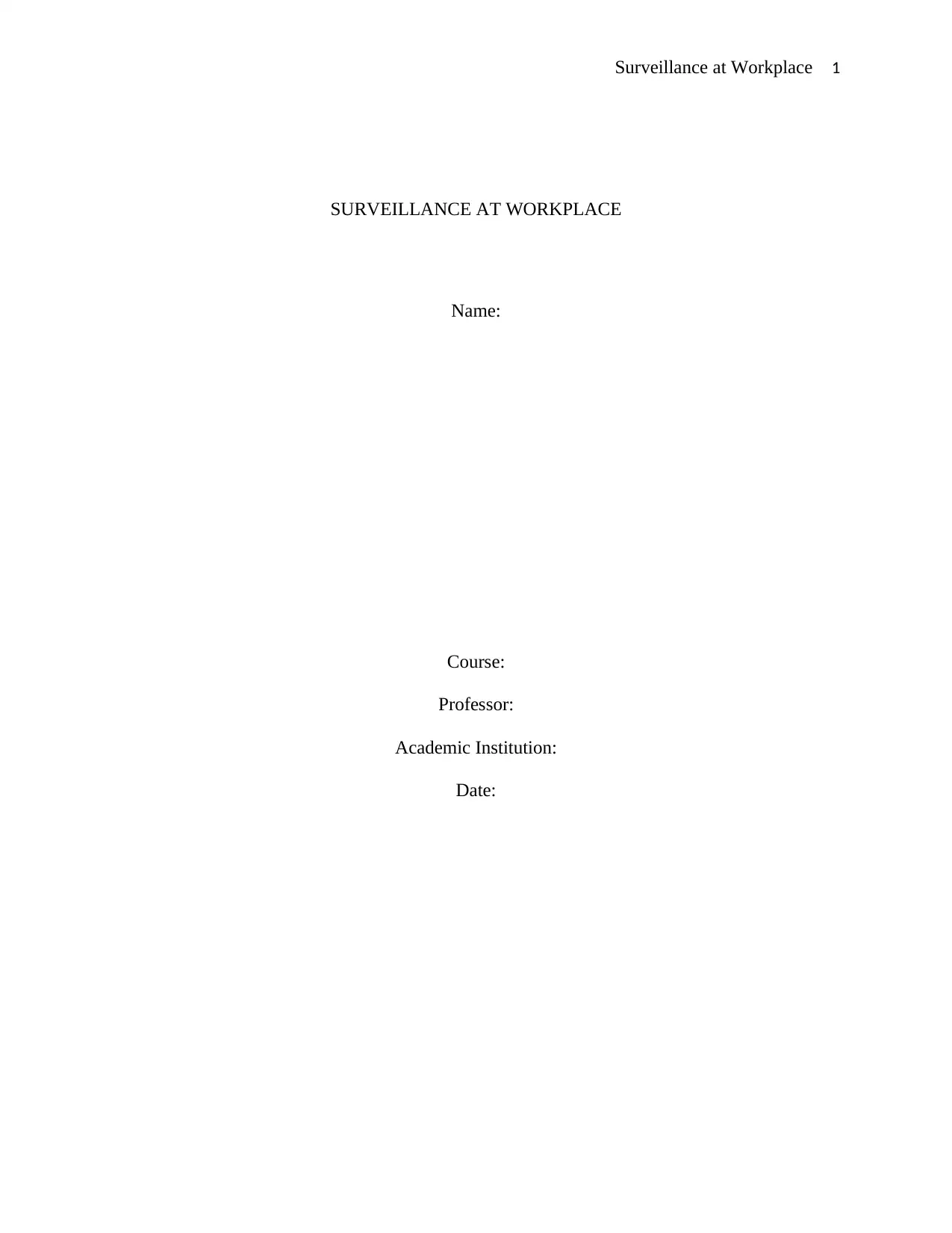
Surveillance at Workplace 1
SURVEILLANCE AT WORKPLACE
Name:
Course:
Professor:
Academic Institution:
Date:
SURVEILLANCE AT WORKPLACE
Name:
Course:
Professor:
Academic Institution:
Date:
Paraphrase This Document
Need a fresh take? Get an instant paraphrase of this document with our AI Paraphraser
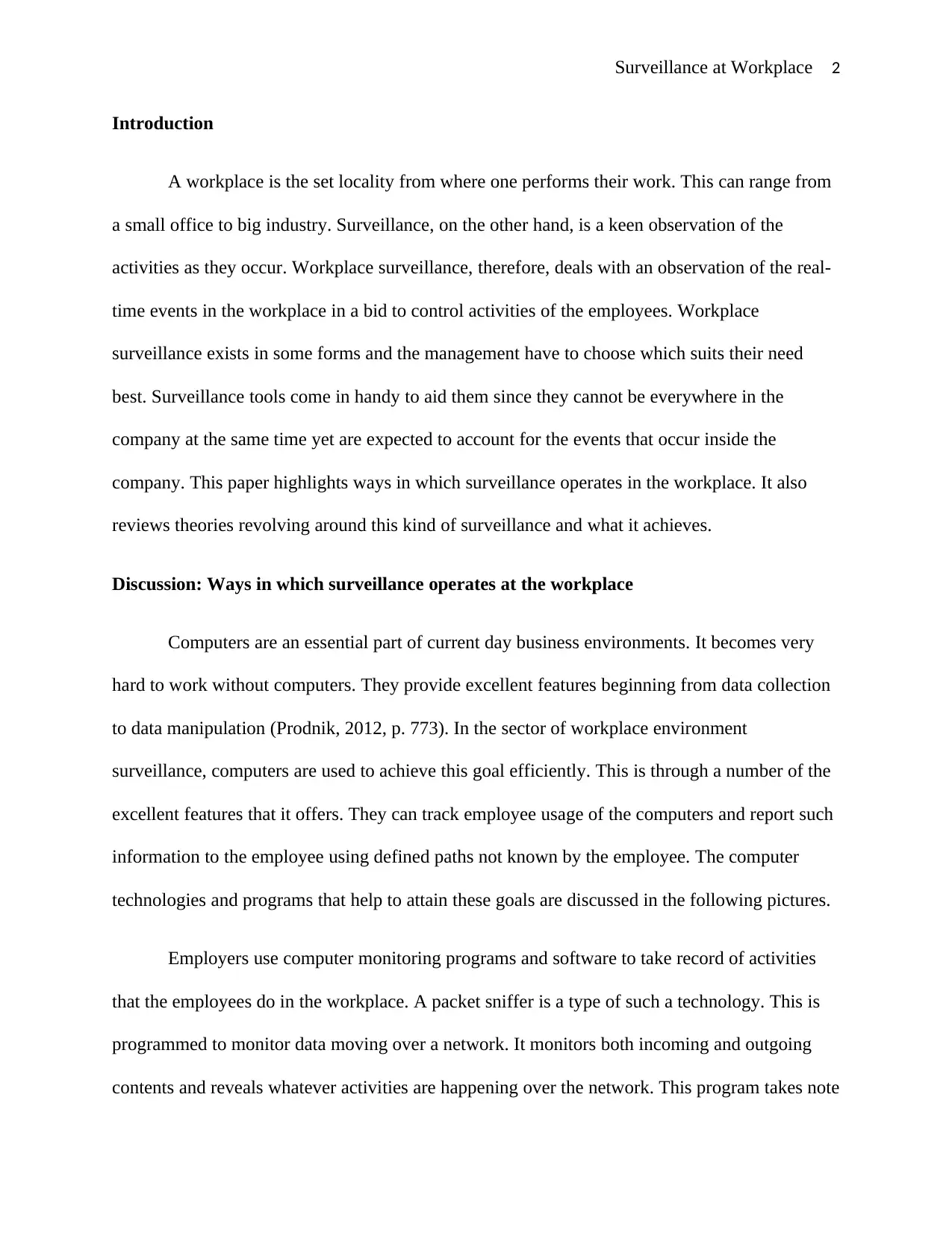
Surveillance at Workplace 2
Introduction
A workplace is the set locality from where one performs their work. This can range from
a small office to big industry. Surveillance, on the other hand, is a keen observation of the
activities as they occur. Workplace surveillance, therefore, deals with an observation of the real-
time events in the workplace in a bid to control activities of the employees. Workplace
surveillance exists in some forms and the management have to choose which suits their need
best. Surveillance tools come in handy to aid them since they cannot be everywhere in the
company at the same time yet are expected to account for the events that occur inside the
company. This paper highlights ways in which surveillance operates in the workplace. It also
reviews theories revolving around this kind of surveillance and what it achieves.
Discussion: Ways in which surveillance operates at the workplace
Computers are an essential part of current day business environments. It becomes very
hard to work without computers. They provide excellent features beginning from data collection
to data manipulation (Prodnik, 2012, p. 773). In the sector of workplace environment
surveillance, computers are used to achieve this goal efficiently. This is through a number of the
excellent features that it offers. They can track employee usage of the computers and report such
information to the employee using defined paths not known by the employee. The computer
technologies and programs that help to attain these goals are discussed in the following pictures.
Employers use computer monitoring programs and software to take record of activities
that the employees do in the workplace. A packet sniffer is a type of such a technology. This is
programmed to monitor data moving over a network. It monitors both incoming and outgoing
contents and reveals whatever activities are happening over the network. This program takes note
Introduction
A workplace is the set locality from where one performs their work. This can range from
a small office to big industry. Surveillance, on the other hand, is a keen observation of the
activities as they occur. Workplace surveillance, therefore, deals with an observation of the real-
time events in the workplace in a bid to control activities of the employees. Workplace
surveillance exists in some forms and the management have to choose which suits their need
best. Surveillance tools come in handy to aid them since they cannot be everywhere in the
company at the same time yet are expected to account for the events that occur inside the
company. This paper highlights ways in which surveillance operates in the workplace. It also
reviews theories revolving around this kind of surveillance and what it achieves.
Discussion: Ways in which surveillance operates at the workplace
Computers are an essential part of current day business environments. It becomes very
hard to work without computers. They provide excellent features beginning from data collection
to data manipulation (Prodnik, 2012, p. 773). In the sector of workplace environment
surveillance, computers are used to achieve this goal efficiently. This is through a number of the
excellent features that it offers. They can track employee usage of the computers and report such
information to the employee using defined paths not known by the employee. The computer
technologies and programs that help to attain these goals are discussed in the following pictures.
Employers use computer monitoring programs and software to take record of activities
that the employees do in the workplace. A packet sniffer is a type of such a technology. This is
programmed to monitor data moving over a network. It monitors both incoming and outgoing
contents and reveals whatever activities are happening over the network. This program takes note
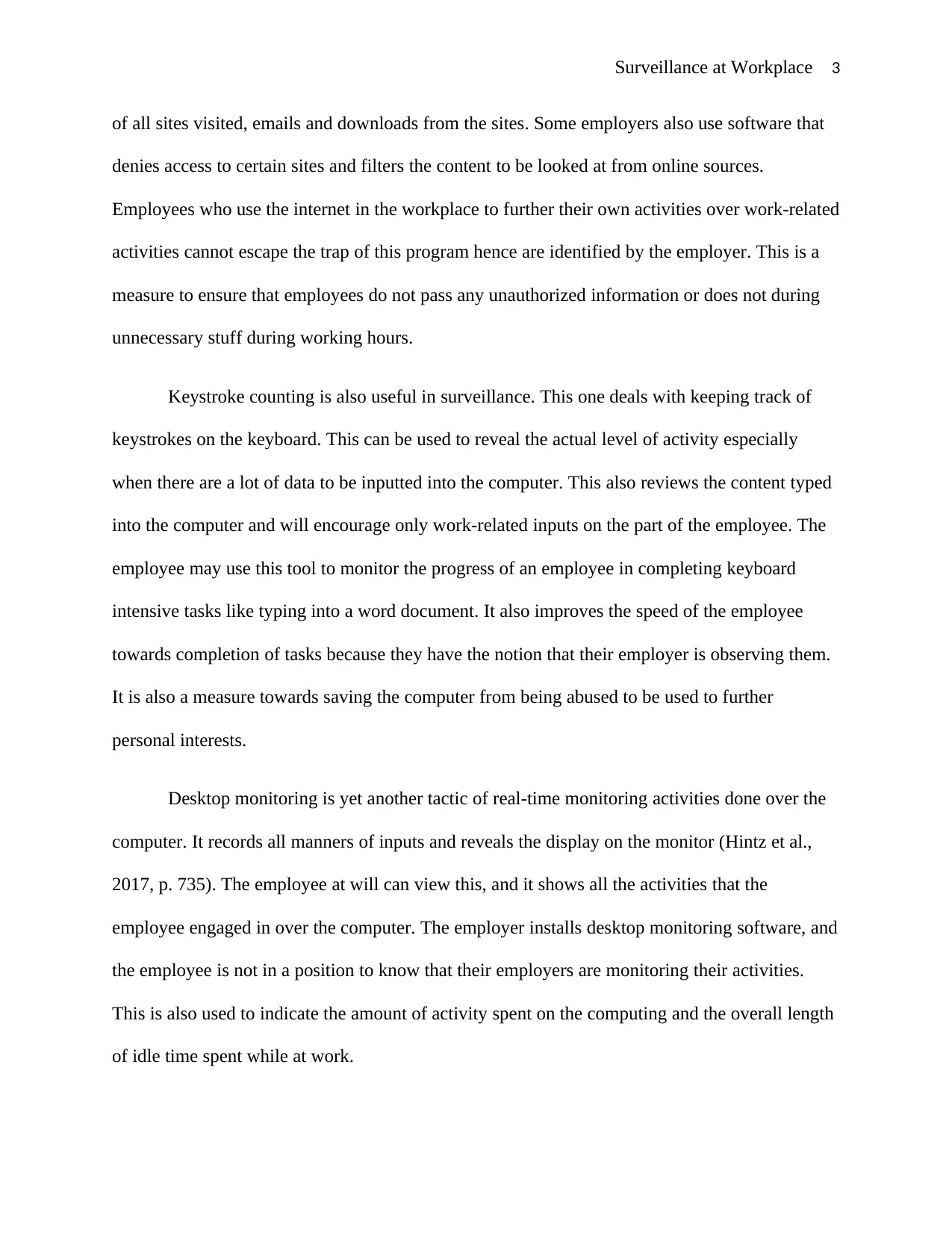
Surveillance at Workplace 3
of all sites visited, emails and downloads from the sites. Some employers also use software that
denies access to certain sites and filters the content to be looked at from online sources.
Employees who use the internet in the workplace to further their own activities over work-related
activities cannot escape the trap of this program hence are identified by the employer. This is a
measure to ensure that employees do not pass any unauthorized information or does not during
unnecessary stuff during working hours.
Keystroke counting is also useful in surveillance. This one deals with keeping track of
keystrokes on the keyboard. This can be used to reveal the actual level of activity especially
when there are a lot of data to be inputted into the computer. This also reviews the content typed
into the computer and will encourage only work-related inputs on the part of the employee. The
employee may use this tool to monitor the progress of an employee in completing keyboard
intensive tasks like typing into a word document. It also improves the speed of the employee
towards completion of tasks because they have the notion that their employer is observing them.
It is also a measure towards saving the computer from being abused to be used to further
personal interests.
Desktop monitoring is yet another tactic of real-time monitoring activities done over the
computer. It records all manners of inputs and reveals the display on the monitor (Hintz et al.,
2017, p. 735). The employee at will can view this, and it shows all the activities that the
employee engaged in over the computer. The employer installs desktop monitoring software, and
the employee is not in a position to know that their employers are monitoring their activities.
This is also used to indicate the amount of activity spent on the computing and the overall length
of idle time spent while at work.
of all sites visited, emails and downloads from the sites. Some employers also use software that
denies access to certain sites and filters the content to be looked at from online sources.
Employees who use the internet in the workplace to further their own activities over work-related
activities cannot escape the trap of this program hence are identified by the employer. This is a
measure to ensure that employees do not pass any unauthorized information or does not during
unnecessary stuff during working hours.
Keystroke counting is also useful in surveillance. This one deals with keeping track of
keystrokes on the keyboard. This can be used to reveal the actual level of activity especially
when there are a lot of data to be inputted into the computer. This also reviews the content typed
into the computer and will encourage only work-related inputs on the part of the employee. The
employee may use this tool to monitor the progress of an employee in completing keyboard
intensive tasks like typing into a word document. It also improves the speed of the employee
towards completion of tasks because they have the notion that their employer is observing them.
It is also a measure towards saving the computer from being abused to be used to further
personal interests.
Desktop monitoring is yet another tactic of real-time monitoring activities done over the
computer. It records all manners of inputs and reveals the display on the monitor (Hintz et al.,
2017, p. 735). The employee at will can view this, and it shows all the activities that the
employee engaged in over the computer. The employer installs desktop monitoring software, and
the employee is not in a position to know that their employers are monitoring their activities.
This is also used to indicate the amount of activity spent on the computing and the overall length
of idle time spent while at work.
⊘ This is a preview!⊘
Do you want full access?
Subscribe today to unlock all pages.

Trusted by 1+ million students worldwide
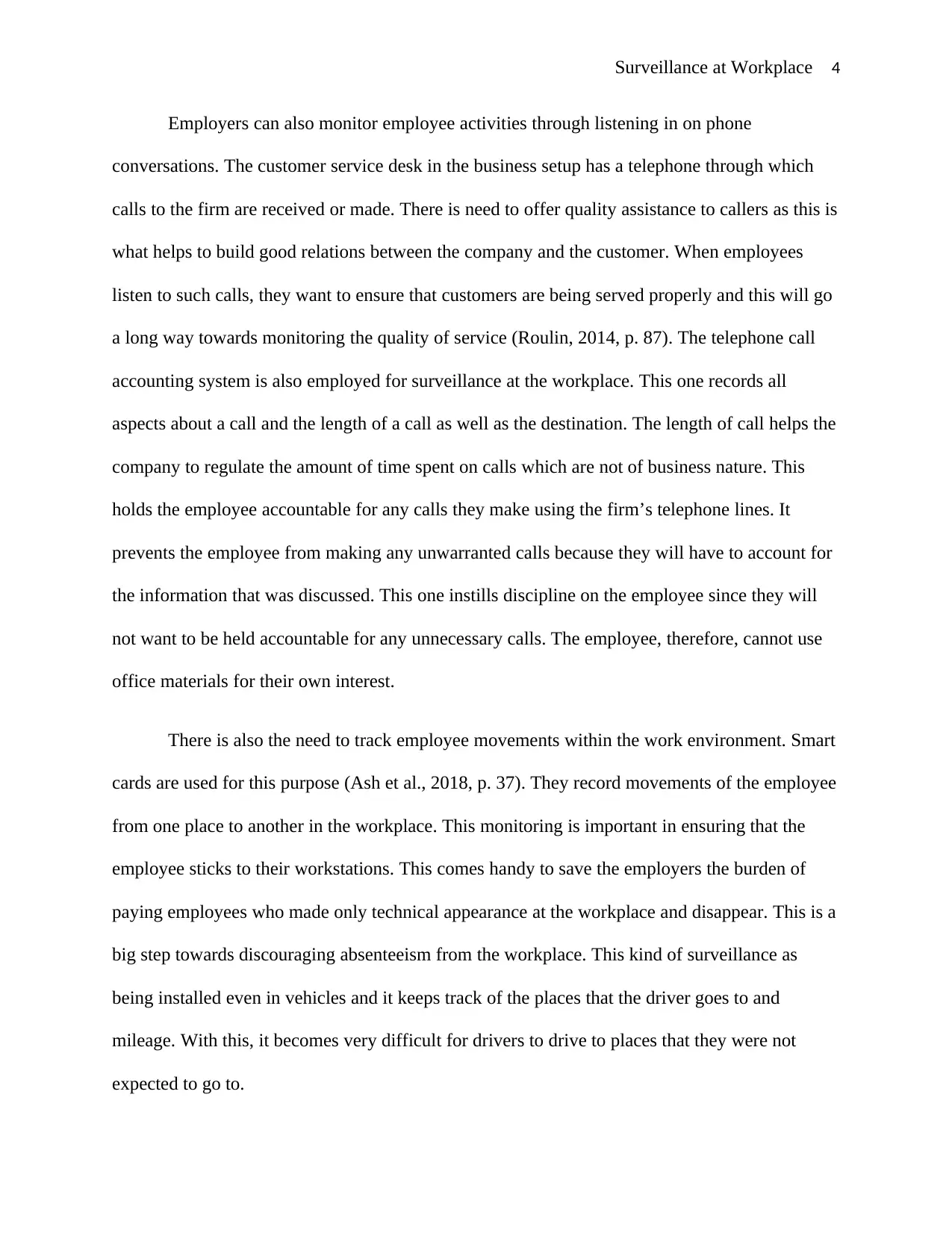
Surveillance at Workplace 4
Employers can also monitor employee activities through listening in on phone
conversations. The customer service desk in the business setup has a telephone through which
calls to the firm are received or made. There is need to offer quality assistance to callers as this is
what helps to build good relations between the company and the customer. When employees
listen to such calls, they want to ensure that customers are being served properly and this will go
a long way towards monitoring the quality of service (Roulin, 2014, p. 87). The telephone call
accounting system is also employed for surveillance at the workplace. This one records all
aspects about a call and the length of a call as well as the destination. The length of call helps the
company to regulate the amount of time spent on calls which are not of business nature. This
holds the employee accountable for any calls they make using the firm’s telephone lines. It
prevents the employee from making any unwarranted calls because they will have to account for
the information that was discussed. This one instills discipline on the employee since they will
not want to be held accountable for any unnecessary calls. The employee, therefore, cannot use
office materials for their own interest.
There is also the need to track employee movements within the work environment. Smart
cards are used for this purpose (Ash et al., 2018, p. 37). They record movements of the employee
from one place to another in the workplace. This monitoring is important in ensuring that the
employee sticks to their workstations. This comes handy to save the employers the burden of
paying employees who made only technical appearance at the workplace and disappear. This is a
big step towards discouraging absenteeism from the workplace. This kind of surveillance as
being installed even in vehicles and it keeps track of the places that the driver goes to and
mileage. With this, it becomes very difficult for drivers to drive to places that they were not
expected to go to.
Employers can also monitor employee activities through listening in on phone
conversations. The customer service desk in the business setup has a telephone through which
calls to the firm are received or made. There is need to offer quality assistance to callers as this is
what helps to build good relations between the company and the customer. When employees
listen to such calls, they want to ensure that customers are being served properly and this will go
a long way towards monitoring the quality of service (Roulin, 2014, p. 87). The telephone call
accounting system is also employed for surveillance at the workplace. This one records all
aspects about a call and the length of a call as well as the destination. The length of call helps the
company to regulate the amount of time spent on calls which are not of business nature. This
holds the employee accountable for any calls they make using the firm’s telephone lines. It
prevents the employee from making any unwarranted calls because they will have to account for
the information that was discussed. This one instills discipline on the employee since they will
not want to be held accountable for any unnecessary calls. The employee, therefore, cannot use
office materials for their own interest.
There is also the need to track employee movements within the work environment. Smart
cards are used for this purpose (Ash et al., 2018, p. 37). They record movements of the employee
from one place to another in the workplace. This monitoring is important in ensuring that the
employee sticks to their workstations. This comes handy to save the employers the burden of
paying employees who made only technical appearance at the workplace and disappear. This is a
big step towards discouraging absenteeism from the workplace. This kind of surveillance as
being installed even in vehicles and it keeps track of the places that the driver goes to and
mileage. With this, it becomes very difficult for drivers to drive to places that they were not
expected to go to.
Paraphrase This Document
Need a fresh take? Get an instant paraphrase of this document with our AI Paraphraser
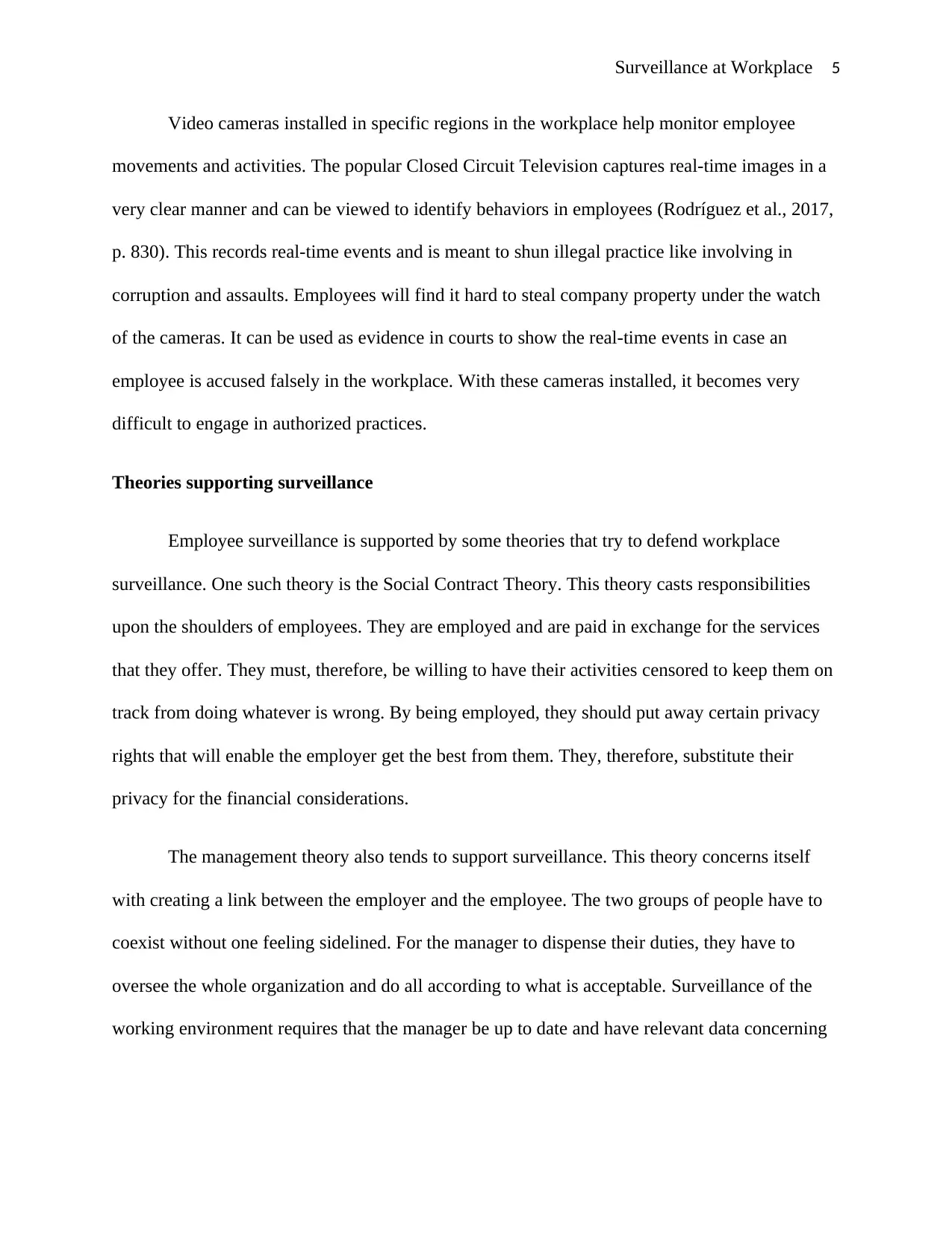
Surveillance at Workplace 5
Video cameras installed in specific regions in the workplace help monitor employee
movements and activities. The popular Closed Circuit Television captures real-time images in a
very clear manner and can be viewed to identify behaviors in employees (Rodríguez et al., 2017,
p. 830). This records real-time events and is meant to shun illegal practice like involving in
corruption and assaults. Employees will find it hard to steal company property under the watch
of the cameras. It can be used as evidence in courts to show the real-time events in case an
employee is accused falsely in the workplace. With these cameras installed, it becomes very
difficult to engage in authorized practices.
Theories supporting surveillance
Employee surveillance is supported by some theories that try to defend workplace
surveillance. One such theory is the Social Contract Theory. This theory casts responsibilities
upon the shoulders of employees. They are employed and are paid in exchange for the services
that they offer. They must, therefore, be willing to have their activities censored to keep them on
track from doing whatever is wrong. By being employed, they should put away certain privacy
rights that will enable the employer get the best from them. They, therefore, substitute their
privacy for the financial considerations.
The management theory also tends to support surveillance. This theory concerns itself
with creating a link between the employer and the employee. The two groups of people have to
coexist without one feeling sidelined. For the manager to dispense their duties, they have to
oversee the whole organization and do all according to what is acceptable. Surveillance of the
working environment requires that the manager be up to date and have relevant data concerning
Video cameras installed in specific regions in the workplace help monitor employee
movements and activities. The popular Closed Circuit Television captures real-time images in a
very clear manner and can be viewed to identify behaviors in employees (Rodríguez et al., 2017,
p. 830). This records real-time events and is meant to shun illegal practice like involving in
corruption and assaults. Employees will find it hard to steal company property under the watch
of the cameras. It can be used as evidence in courts to show the real-time events in case an
employee is accused falsely in the workplace. With these cameras installed, it becomes very
difficult to engage in authorized practices.
Theories supporting surveillance
Employee surveillance is supported by some theories that try to defend workplace
surveillance. One such theory is the Social Contract Theory. This theory casts responsibilities
upon the shoulders of employees. They are employed and are paid in exchange for the services
that they offer. They must, therefore, be willing to have their activities censored to keep them on
track from doing whatever is wrong. By being employed, they should put away certain privacy
rights that will enable the employer get the best from them. They, therefore, substitute their
privacy for the financial considerations.
The management theory also tends to support surveillance. This theory concerns itself
with creating a link between the employer and the employee. The two groups of people have to
coexist without one feeling sidelined. For the manager to dispense their duties, they have to
oversee the whole organization and do all according to what is acceptable. Surveillance of the
working environment requires that the manager be up to date and have relevant data concerning
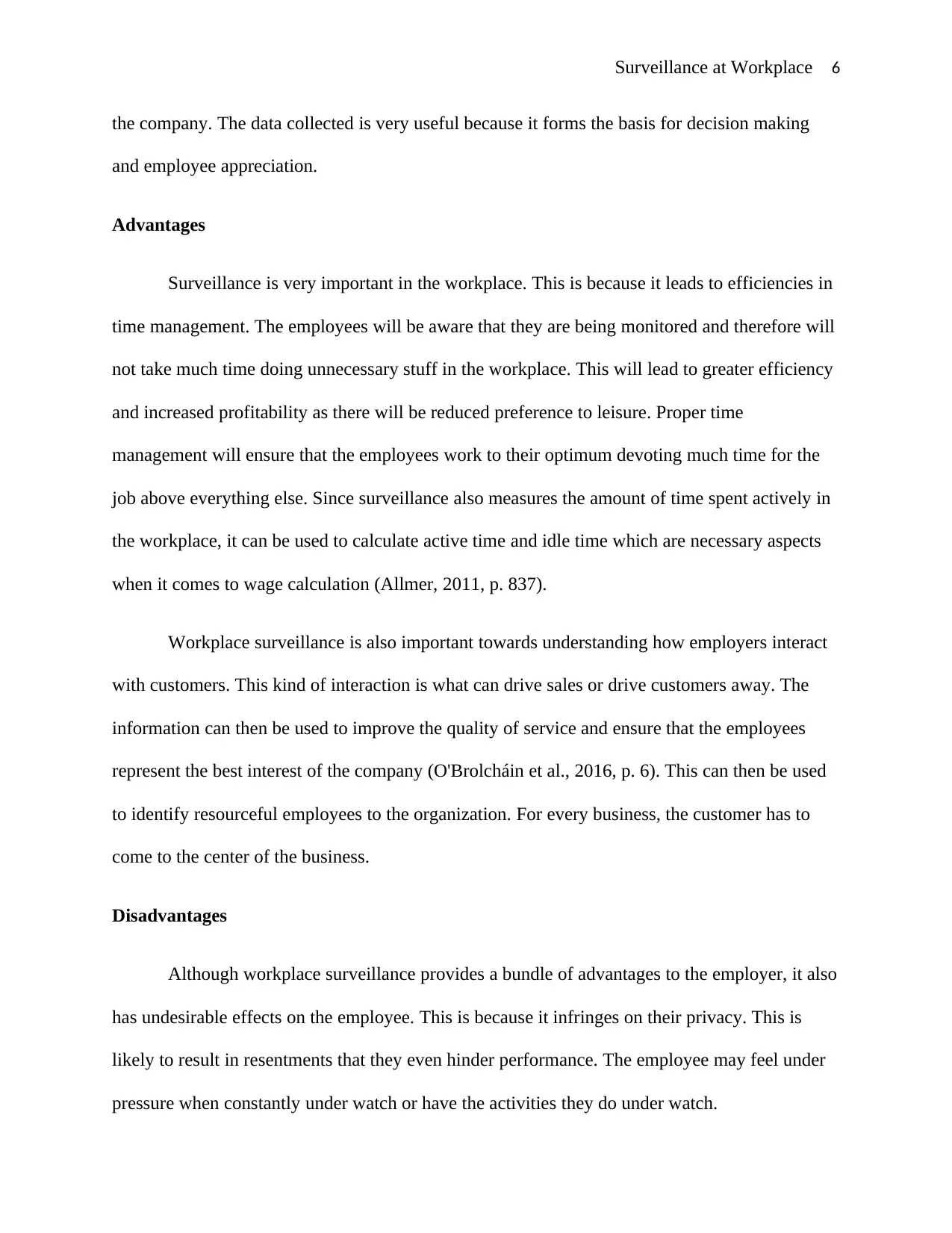
Surveillance at Workplace 6
the company. The data collected is very useful because it forms the basis for decision making
and employee appreciation.
Advantages
Surveillance is very important in the workplace. This is because it leads to efficiencies in
time management. The employees will be aware that they are being monitored and therefore will
not take much time doing unnecessary stuff in the workplace. This will lead to greater efficiency
and increased profitability as there will be reduced preference to leisure. Proper time
management will ensure that the employees work to their optimum devoting much time for the
job above everything else. Since surveillance also measures the amount of time spent actively in
the workplace, it can be used to calculate active time and idle time which are necessary aspects
when it comes to wage calculation (Allmer, 2011, p. 837).
Workplace surveillance is also important towards understanding how employers interact
with customers. This kind of interaction is what can drive sales or drive customers away. The
information can then be used to improve the quality of service and ensure that the employees
represent the best interest of the company (O'Brolcháin et al., 2016, p. 6). This can then be used
to identify resourceful employees to the organization. For every business, the customer has to
come to the center of the business.
Disadvantages
Although workplace surveillance provides a bundle of advantages to the employer, it also
has undesirable effects on the employee. This is because it infringes on their privacy. This is
likely to result in resentments that they even hinder performance. The employee may feel under
pressure when constantly under watch or have the activities they do under watch.
the company. The data collected is very useful because it forms the basis for decision making
and employee appreciation.
Advantages
Surveillance is very important in the workplace. This is because it leads to efficiencies in
time management. The employees will be aware that they are being monitored and therefore will
not take much time doing unnecessary stuff in the workplace. This will lead to greater efficiency
and increased profitability as there will be reduced preference to leisure. Proper time
management will ensure that the employees work to their optimum devoting much time for the
job above everything else. Since surveillance also measures the amount of time spent actively in
the workplace, it can be used to calculate active time and idle time which are necessary aspects
when it comes to wage calculation (Allmer, 2011, p. 837).
Workplace surveillance is also important towards understanding how employers interact
with customers. This kind of interaction is what can drive sales or drive customers away. The
information can then be used to improve the quality of service and ensure that the employees
represent the best interest of the company (O'Brolcháin et al., 2016, p. 6). This can then be used
to identify resourceful employees to the organization. For every business, the customer has to
come to the center of the business.
Disadvantages
Although workplace surveillance provides a bundle of advantages to the employer, it also
has undesirable effects on the employee. This is because it infringes on their privacy. This is
likely to result in resentments that they even hinder performance. The employee may feel under
pressure when constantly under watch or have the activities they do under watch.
⊘ This is a preview!⊘
Do you want full access?
Subscribe today to unlock all pages.

Trusted by 1+ million students worldwide
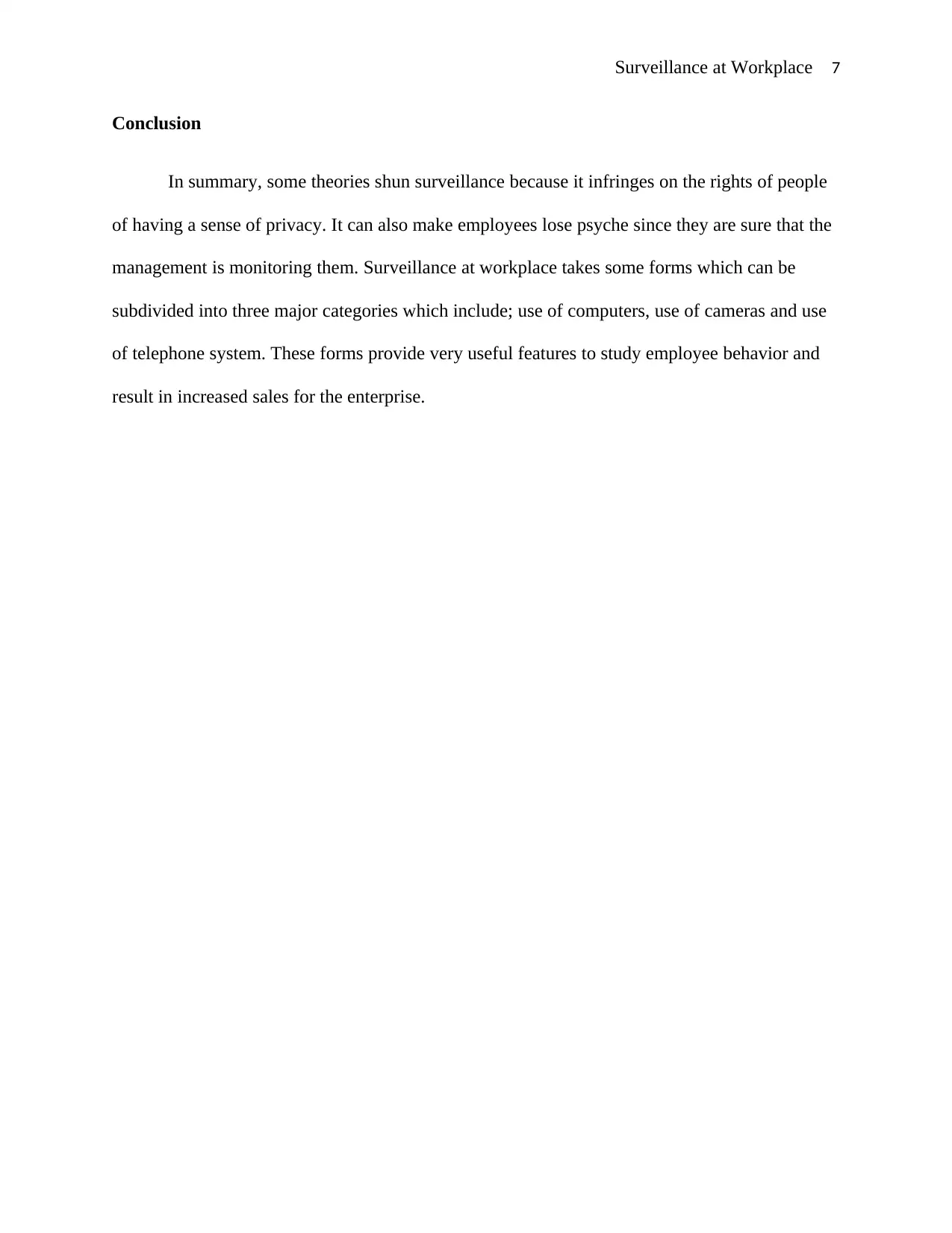
Surveillance at Workplace 7
Conclusion
In summary, some theories shun surveillance because it infringes on the rights of people
of having a sense of privacy. It can also make employees lose psyche since they are sure that the
management is monitoring them. Surveillance at workplace takes some forms which can be
subdivided into three major categories which include; use of computers, use of cameras and use
of telephone system. These forms provide very useful features to study employee behavior and
result in increased sales for the enterprise.
Conclusion
In summary, some theories shun surveillance because it infringes on the rights of people
of having a sense of privacy. It can also make employees lose psyche since they are sure that the
management is monitoring them. Surveillance at workplace takes some forms which can be
subdivided into three major categories which include; use of computers, use of cameras and use
of telephone system. These forms provide very useful features to study employee behavior and
result in increased sales for the enterprise.
Paraphrase This Document
Need a fresh take? Get an instant paraphrase of this document with our AI Paraphraser
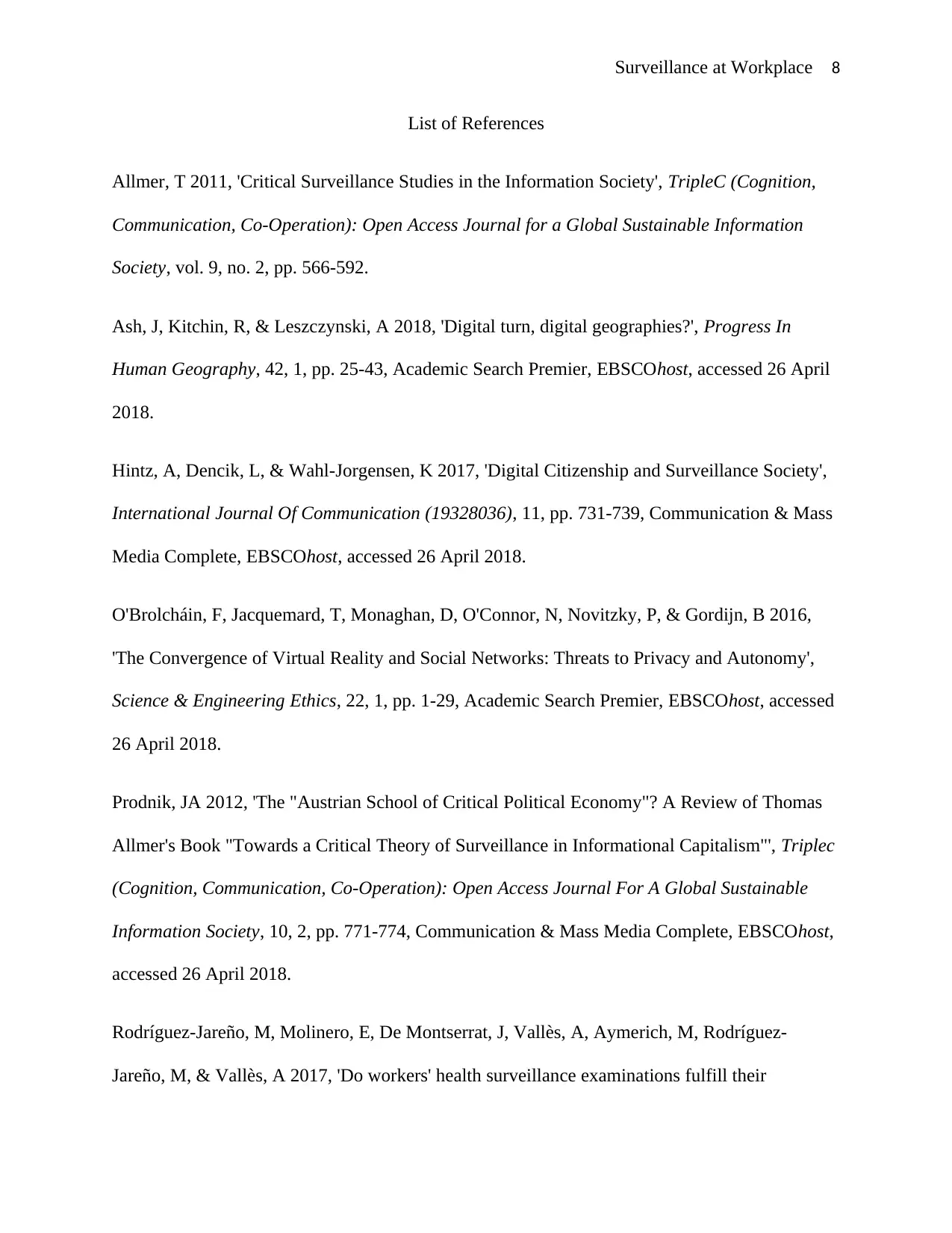
Surveillance at Workplace 8
List of References
Allmer, T 2011, 'Critical Surveillance Studies in the Information Society', TripleC (Cognition,
Communication, Co-Operation): Open Access Journal for a Global Sustainable Information
Society, vol. 9, no. 2, pp. 566-592.
Ash, J, Kitchin, R, & Leszczynski, A 2018, 'Digital turn, digital geographies?', Progress In
Human Geography, 42, 1, pp. 25-43, Academic Search Premier, EBSCOhost, accessed 26 April
2018.
Hintz, A, Dencik, L, & Wahl-Jorgensen, K 2017, 'Digital Citizenship and Surveillance Society',
International Journal Of Communication (19328036), 11, pp. 731-739, Communication & Mass
Media Complete, EBSCOhost, accessed 26 April 2018.
O'Brolcháin, F, Jacquemard, T, Monaghan, D, O'Connor, N, Novitzky, P, & Gordijn, B 2016,
'The Convergence of Virtual Reality and Social Networks: Threats to Privacy and Autonomy',
Science & Engineering Ethics, 22, 1, pp. 1-29, Academic Search Premier, EBSCOhost, accessed
26 April 2018.
Prodnik, JA 2012, 'The "Austrian School of Critical Political Economy"? A Review of Thomas
Allmer's Book "Towards a Critical Theory of Surveillance in Informational Capitalism"', Triplec
(Cognition, Communication, Co-Operation): Open Access Journal For A Global Sustainable
Information Society, 10, 2, pp. 771-774, Communication & Mass Media Complete, EBSCOhost,
accessed 26 April 2018.
Rodríguez-Jareño, M, Molinero, E, De Montserrat, J, Vallès, A, Aymerich, M, Rodríguez-
Jareño, M, & Vallès, A 2017, 'Do workers' health surveillance examinations fulfill their
List of References
Allmer, T 2011, 'Critical Surveillance Studies in the Information Society', TripleC (Cognition,
Communication, Co-Operation): Open Access Journal for a Global Sustainable Information
Society, vol. 9, no. 2, pp. 566-592.
Ash, J, Kitchin, R, & Leszczynski, A 2018, 'Digital turn, digital geographies?', Progress In
Human Geography, 42, 1, pp. 25-43, Academic Search Premier, EBSCOhost, accessed 26 April
2018.
Hintz, A, Dencik, L, & Wahl-Jorgensen, K 2017, 'Digital Citizenship and Surveillance Society',
International Journal Of Communication (19328036), 11, pp. 731-739, Communication & Mass
Media Complete, EBSCOhost, accessed 26 April 2018.
O'Brolcháin, F, Jacquemard, T, Monaghan, D, O'Connor, N, Novitzky, P, & Gordijn, B 2016,
'The Convergence of Virtual Reality and Social Networks: Threats to Privacy and Autonomy',
Science & Engineering Ethics, 22, 1, pp. 1-29, Academic Search Premier, EBSCOhost, accessed
26 April 2018.
Prodnik, JA 2012, 'The "Austrian School of Critical Political Economy"? A Review of Thomas
Allmer's Book "Towards a Critical Theory of Surveillance in Informational Capitalism"', Triplec
(Cognition, Communication, Co-Operation): Open Access Journal For A Global Sustainable
Information Society, 10, 2, pp. 771-774, Communication & Mass Media Complete, EBSCOhost,
accessed 26 April 2018.
Rodríguez-Jareño, M, Molinero, E, De Montserrat, J, Vallès, A, Aymerich, M, Rodríguez-
Jareño, M, & Vallès, A 2017, 'Do workers' health surveillance examinations fulfill their
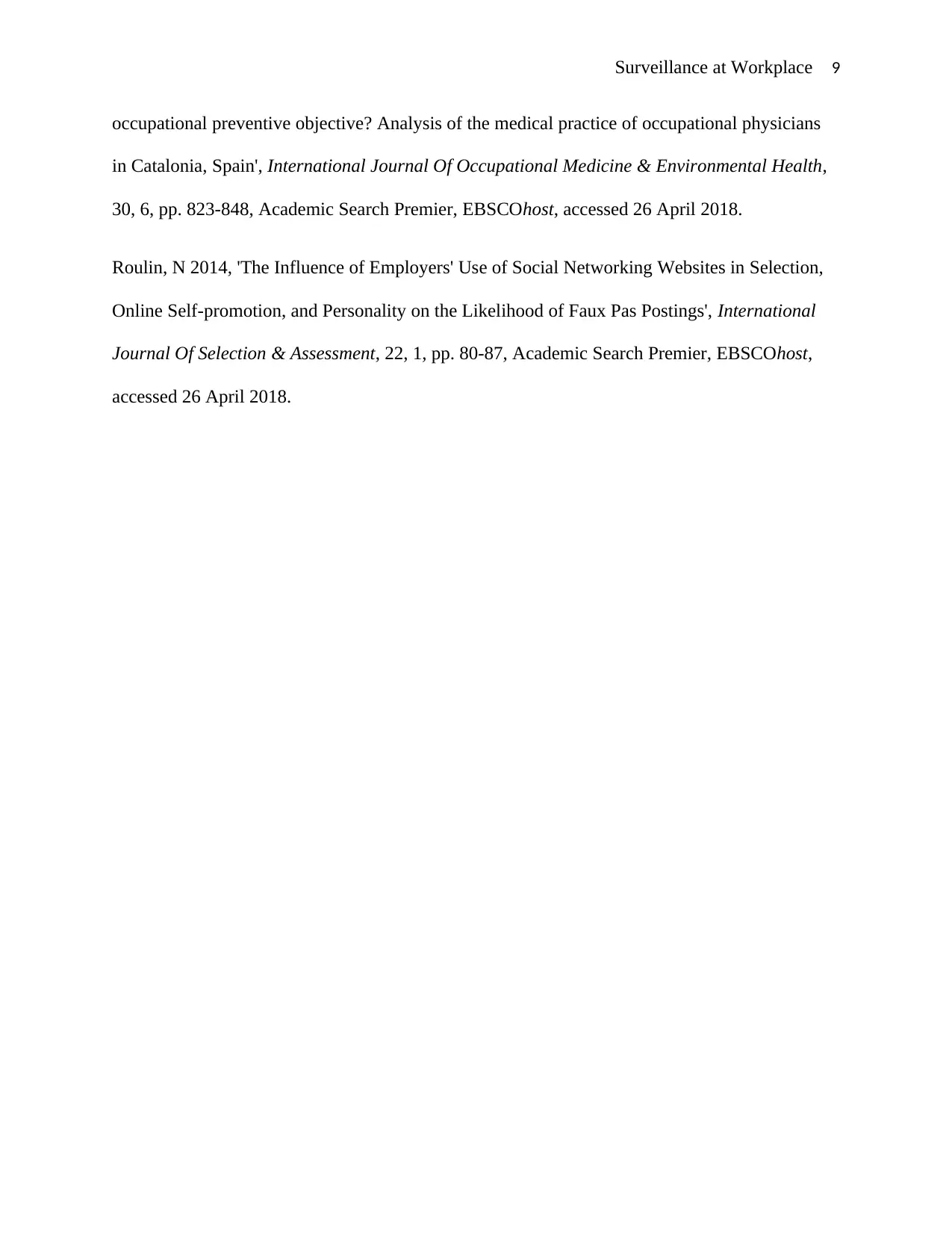
Surveillance at Workplace 9
occupational preventive objective? Analysis of the medical practice of occupational physicians
in Catalonia, Spain', International Journal Of Occupational Medicine & Environmental Health,
30, 6, pp. 823-848, Academic Search Premier, EBSCOhost, accessed 26 April 2018.
Roulin, N 2014, 'The Influence of Employers' Use of Social Networking Websites in Selection,
Online Self-promotion, and Personality on the Likelihood of Faux Pas Postings', International
Journal Of Selection & Assessment, 22, 1, pp. 80-87, Academic Search Premier, EBSCOhost,
accessed 26 April 2018.
occupational preventive objective? Analysis of the medical practice of occupational physicians
in Catalonia, Spain', International Journal Of Occupational Medicine & Environmental Health,
30, 6, pp. 823-848, Academic Search Premier, EBSCOhost, accessed 26 April 2018.
Roulin, N 2014, 'The Influence of Employers' Use of Social Networking Websites in Selection,
Online Self-promotion, and Personality on the Likelihood of Faux Pas Postings', International
Journal Of Selection & Assessment, 22, 1, pp. 80-87, Academic Search Premier, EBSCOhost,
accessed 26 April 2018.
⊘ This is a preview!⊘
Do you want full access?
Subscribe today to unlock all pages.

Trusted by 1+ million students worldwide
1 out of 9
Related Documents
Your All-in-One AI-Powered Toolkit for Academic Success.
+13062052269
info@desklib.com
Available 24*7 on WhatsApp / Email
![[object Object]](/_next/static/media/star-bottom.7253800d.svg)
Unlock your academic potential
Copyright © 2020–2025 A2Z Services. All Rights Reserved. Developed and managed by ZUCOL.




